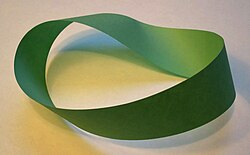Möbius strip
See also: Mobius strip and Moebius strip

English
Alternative forms
Etymology
After the German mathematician and discoverer of the Möbius strip August Ferdinand Möbius (1790-1868), + strip.
Pronunciation
- Lua error in Module:parameters at line 331: Parameter 1 should be a valid language or etymology language code; the value "UK" is not valid. See WT:LOL and WT:LOL/E. IPA(key): /ˈməʊ.biː.əs stɹɪp/
Noun
Möbius strip (plural Möbius strips)
- (topology) A one-sided surface formed by identifying two opposite edges of a square in opposite senses.
- A narrow strip given a half twist and joined at the ends, forming a three-dimensional embedding of the above.
- 2013 November 16, Patrick McGuinness, “Who's afraid of Marcel Proust?”, in The Daily Telegraph (Review)[1], page R20:
- Proust's novel grew and deepened into over 3,000 pages of everything and nothing: a Möbius strip of profundity twisting into mundanity, mundanity twisting into profundity.
Synonyms
- Möbius band
- twisted cylinder (rare)
Derived terms
Related terms
Translations
one-sided surface
|
narrow strip given a half twist
|
- The translations below need to be checked and inserted above into the appropriate translation tables. See instructions at Wiktionary:Entry layout § Translations.
Translations to be checked
|
